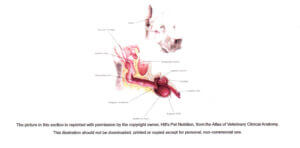
JUST WHAT IS OTITIS EXTERNA?
The definition of Otitis externa is: inflammation of the ear canal. It is very common, aggravating, and a sometimes costly problem for both the dogs and the owners.
Otitis externa is so common in dogs, partly because of their ear anatomy (see below). Dogs have very long, narrow ear canals–inches long in some breeds. Halfway down is a right-angle bend that is a perfect place for debris and liquid to get stuck. Now add to this the pendulous ear flaps that some breeds have (most notably, spaniels, beagles, and retrievers). This has the effect of sealing in warmth and moisture, creating the perfect environment for yeast and bacteria to flourish.

WHAT ARE THE SIGNS OF OTITIS EXTERNA IN DOGS?
Your dog will give you plenty of signs when he or she has an ear infection. Head shaking, scratching at the ears, redness of the ear canal, brown discharge from the ear, and a foul odor are all hallmarks of this condition. The result may be bleeding skin wounds or an ear hematoma (An aural hematoma is a pool of blood that collects between the skin and the cartilage of a pet’s ear flap. It’s typically caused by overly aggressive ear scratching or head shaking that results from an ear infection). Depression and irritability can ensue as the condition progresses and the ear becomes painful. Hearing can be negatively affected. So can your dog’s balance, coordination, and facial muscles in severe cases.
WHAT CAUSES CANINE OTITIS EXTERNA?
Ear infections in dogs usually arises from a number of factors. Primary factors are those which touch off the inflammatory process. They create moisture, heat, and stagnant air flow in the ear canal and help create the perfect environment for secondary factors–yeast, bacteria, swelling, and debris–to take hold.
THE PRIMARY FACTORS CAUSING EAR INFECTIONS INCLUDE:
- Canine Ear Anatomy
Certain dogs are particularly susceptible to ear infections due to their heavy, pendulous ear flaps. The ear flaps trap warm air, debris, and moisture in the ear canal, causing the perfect environment for organisms to grow and flourish. Spaniels, Basset hounds, and retrievers are notorious examples of floppy-eared dogs that are especially prone to ear problems.
2. The Dog’s Environment
A lot of swimming, exposure to plants and pollen, time spent in wooded areas where plant awns or burrs can get lodged in the ear, or simply the humid heat of summer can set the stage for ear trouble in dogs.
3. Canine Allergies
Itchy, infected ears are the common sign of allergic skin disease in dogs. In fact, otitis externa may be the first or only sign of many canine allergies. What starts out as a simple ear infection can often become a chronic problem until the underlying allergy is diagnosed and treated.
4. Canine Parasites
Ear mites (Otodectes), are less common in dogs than cats. Ear mites cause inflammation, copious discharge, and an intense itch that can lead to self-trauma and secondary infection. Fortunately, ear mites are easy to treat with proper veterinary care.
5. Foreign Bodies in the Dog’s Ears
Plant “stickers” or plant awns can get lodged in the ear and cause intense scratching and secondary infection.
6. Ear Tumors in Canines
Tumors that are infected in the ear can trap moisture and debris, and are the perfect place for organisms like bacteria and yeast to grow.
7. Other Medical Conditions Affecting The Dog’s Ears
Hormonal imbalances such as hypothyroidism and generalized skin disorders including seborrhea, can spark the inflammation that leads to otitis externa in dogs.
THE DIAGNOSIS OF OTITIS EXTERNA IN DOGS
A painful irritating ear infection in a dog is hard to miss. But treatments only work if both the primary and secondary causes are addressed.
Your veterinarian will first perform a full history and physical examination. What is your dog’s routine, is he a swimmer?, been given a bath recently?, is there redness, a rash, loss of hair on the rest of the body, or are there other signs of generalized skin disease? What previous treatment has been tried and with what degree of success.
The next step your veterinarian will take is to zero in on the ears. This will include an external exam of the ear flap, the ear opening and related structures, as well as a deep look into the ear canal with a special instrument called an otoscope. A dog in pain may try to resist this exam, so it must sometimes be done under sedation. Your vet may take samples for microscopic examination or for a culture to identify yeast and bacteria. Radiographs (x-rays) and biopsy may be indicated in some cases. Veterinary specialists often have high-tech fiber-optic scopes that allow even better evaluation and sample collection from deep within the dog’s ear.
HOW TO TREAT OTITIS EXTERNA
The first step in treating otitis externa is a thorough cleaning of the affected ear(s). With a deep cleaning the ear will be rid of secondary factors such as yeast, bacteria, and debris. In mild to moderate cases, ear cleaning may be done with a routine office visit. Your veterinarian will use a medicated ear cleaning solution along with gauze or cotton balls to remove excess fluid and debris. In severe cases, your vet may recommend that an ear flush be conducted under general anesthesia. When this is done, special probes and deep flushing equipment can be used.
When the ear is clean and dry, topical medications are prescribed to keep the yeast and bacteria at bay. Your veterinarian will prescribe ointments or solutions that contain any of a combination of antibacterial, anti-yeast, and anti-itch medications. In more severe cases, oral antibiotics, antihistamines, or even oral steroids may be needed to get infection and inflammation under control.
For the treatment to be successful, the primary factors contributing to the ear infection need to be addressed. This may require your vet to treat for ear mites, address allergic skin disorders, or remove a foreign body from the ear canal. Your veterinarian may recommend cutting back on swimming during the warm summer months, or at least following it with a good ear cleansing with a cleaner that includes a drying agent. Your vet may do blood work and other diagnostics to probe for underlying health issues such as hypothyroidism.
TREATMENT AND COMPLICATIONS OF OTITIS EXTERNA IN DOGS
If a dog’s ear infection continues for weeks and months, many complications can arise. Some are irreversible. These include:
1. Chronic Ear Canal Changes
Years of infection and inflammation take their toll on the skin of ear canals. Scarring and swelling causes them to close down, trapping fluid and debris even worse than before. Over time, the ear canals can literally solidify with hard-as-bone scar tissue. Major corrective surgery is often the only resource at this stage.
2. Ear Hematomas
When a dog violently shakes his head from an intensely itchy case of otitis externa, the ear flap can actually be injured, breaking blood vessels below the skin surface. The result is an ear hematoma (called “pillow ear”). Ear hematoma is painful if the skin is stretched far enough. Even if the dog doesn’t seem to be in pain, a hermatoma should be treated promptly to reduce the chance of a disfigured ear flap. Treatment of an ear hematoma is surgical and involves draining the fluid from the hematoma and using special sutures to tack the ear flap flat again. Your veterinarian will also strive to identify and treat the itch-inducing ear problem, to decrease the chance of recurrence.
3. Middle And Inner Ear Infection
The external ear canal is separated from the middle ear cavity and inner ear (cochlea) by a thin fibrous membrane – the ear drum. Severe or ongoing otitis externa can actually rupture the ear drum. Once the ear drum is breached, it’s not long before yeast and bacteria set up in the area of the middle and inner ear. Symptoms of middle and inner ear infection may include the following:
- Tilting the head to one side
- Circling
- Dizziness
- Poor balance
- Rhythmic eye movements (nystagmus)
- Uneven pupils
- Pain on opening the mouth
- Loss of hearing
These are immediate signs to take your dog to your veterinarian
PREVENTION OF OTITIS EXTERNA IN DOGS
Without saying, for ear disease, prevention is the best remedy. Cleaning your dog’s ears regularly with a gentle ear cleaner can help keep problems under control. Consult your veterinarian detailed advice on preventing otitis externa. The itch-free confort will be heaven-sent to your dog’s ears.
CANINE OTITIS
WHY AM I SEEING CANINE OTITIS IN ONLY ONE EAR?
With each episode of canine otitis there are changes in the ear canal making it worse, and these changes build up over time. After the first episode of otitis, that right ear never went back to normal, and the next ear infection will show up in that ear first, and the next one, and the next one. It has become predisposed by the chronic inflammation that is under the surface.
ARE CULTURES IMPORTANT?
As a rule Dermatologists don’t culture the external ear canal very often–in part because the sensitivity is based on blood levels of antibiotics, and we can get much higher concentrations when we do topical therapy. Cultures also don’t take into account biofilm (the slimy stuff that makes everything goop up to the walls), and they will include antibiotics you can’t get in topical formulations.
So, rarely is the answer, “I did a culture, so now I’m going to have a drug compounded to put in the ear.” While this seems the easy choice, it’s probably not the right choice. Topical therapy really is the cornerstone of otitis treatment. Unless you have otitis media or you see a lot of white blood cells in your otic cytology, an oral antibiotic isn’t going to do much for the patient. It’s not necessarily wrong, but depending on your feeling’s about overusing antibiotics, you might want to consider that.
WHAT ARE THE BEST EAR WASHES?
The one type of ear wash to most often have on hand is a general ear cleaner with a neutral pH, such as Epi-Otic or EpiKlean (these products are used by your vet). These are safe in any ear and can be used for routine cleanings.
If your dog has thick, dry wax (such as cocker spaniels), you might want to get cerumenolytic too. There are two categories: the ones used by your vet and the ones you can use at home.
Cerumenolytics containing squalene are in the first category. These are useful when you have an anesthetized dog or cat with an ear that’s packed with concrete-like wax. However, because these products are so greasy (the idea is that they mix with the wax and lubricate the ear canal so things can come out), many vets only use them. For those of us at home who will use cerumenolytic a micellar solution is recommended. These contain micelles that are really good at dissolving thick, dry wax and are less messy.
There are ear washes that acidify the ear canal. They make the canal especially uninhabitable for yeast because yeast likes a more basic environment. The problem with these products is that they can irritate sensitive ears, and most dogs and cats have sensitive ears. But if you live by a lake and have lots of Labrador patients, you might find it useful to have these on hand. Just remember that they can irritate the ears and that they’re good for yeast infections but not bacterial infections.
When we talk about bacterial infections, cleaners containing Tris-EDTA are another option and should be used whenever you see rod-shaped bacteria on cytology. And here’s why: Most of the time, rod-shaped bacteria are gram negative, and Tris-EDTA takes this gram-negative bacteria and jabs holes in the walls so your antibiotic or antiseptic can find it’s way in. It’s a pre-treatment for the infection.
There are a lot of Tris-EDTA options. Typically, they’re conbined with ketoconazole or miconazole to help prevent Malassezia (but it isn’t used to treat Malassezia infection). Sometimes they’re combined with chlorhexidine, which is the kind to use because chlorhexidine is also antibiofilm, and many of the ears I see also have some slimy stuff in them.
With rod-shaped bacteria, it’s important that you clean the ear and then medicate it about 15 minutes later. You want to flush out as much as you can, and then we want whatever’s left to be weaker so you can throw an antibiotic at it and have it be more effective.
